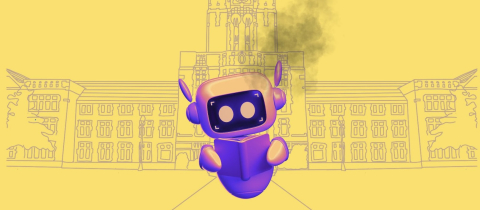Our current methods for decaffeinating coffee are far from ideal. There are a few different methods, all with their own nuanced details, but they all shake out to using some kind of solvent to dissolve and remove caffeine from green coffee beans before roasting. This extra processing means costs to produce decaf are higher, profit margins lower, and production times longer. An even bigger problem is that even the best methods for decaffeination take some aromatic compounds away along with the stimulant molecule, affecting the taste and smell of the resulting coffee.
What if, instead of removing the caffeine from coffee beans, we could grow naturally caffeine-free coffee? Doing just that might be closer on the horizon than we expected.
To know how to stop a coffee plant from producing caffeine, it’s important first to recognize why it’s making it in the first place. Caffeine is a very bitter compound (one of the reasons coffee is a bitter drink), and just as we don’t tend to enjoy overly bitter things, neither do bugs. Coffee plants are believed to produce caffeine in their leaves mainly as a pesticide to defend against being eaten by pests like the coffee berry borer, Hypothenemus hampei.
Interestingly, ancestors of the modern coffee species were probably much lower in caffeine or entirely caffeine-free. The caffeine defence is believed to have developed in central and west Africa, where the coffee berry borer is native. This is where the highest caffeine species of coffee, like Coffea arabica and Coffea canephora, are found. These two species account for nearly 100% of the world’s coffee production.
A fascinating potential method for developing caffeine-free coffee plants involves the subject of the 2021 Nobel Prize in Chemistry: CRISPR/Cas9. Often referred to as “molecular scissors,” the CRISPR/Cas9 tool is inspired by bacterial defence mechanisms against viruses and allows the very precise cutting of an organism’s DNA. In this way, a gene can be targeted and deactivated. A review paper from 2022 took a look at the feasibility of using these molecular scissors to disrupt the biosynthesis of caffeine in coffee plants.
As caffeine is a relatively complex molecule, it isn’t built in just one step. Several enzymes are responsible for precise chemical changes to the proto-caffeine molecule en route to its final form. This is good news for scientists looking to disrupt the synthesis process, as they have multiple enzymes to aim for. The authors of the 2022 review identified an enzyme called XMT as a prime target. XMT is responsible for converting xanthosine into 7-methylxanthosine during step 1 out of 4 in the caffeine synthesis pathway. By targeting the very first step in the process, the subsequent enzymes have no molecules to work on. Debilitating XMT would lead to a build-up of xanthosine, but a different enzyme that can degrade it exists, so it shouldn’t be a problem.
Another potential target is called DXMT. This enzyme is responsible for the penultimate step in caffeine synthesis, converting theobromine into caffeine. Theobromine is quite similar to caffeine structurally and shares some properties with it, like being bitter and toxic to cats and dogs. Importantly, however, theobromine does not have the stimulating effect of caffeine. Targeting and disabling DXMT would lead to a build-up of theobromine in coffee beans, which may actually be a good thing! The bitterness of caffeine is part of the flavour of coffee, meaning that a C. arabica bean without caffeine may still taste different than a C. arabica bean with caffeine, even if they’re otherwise the same. The authors of the study postulate that the increased theobromine content of a DMXT-disabled bean could compensate for the missing bitterness from caffeine.
Genetically engineered caffeine-free coffee could represent a better way of getting our java without the jolt of stimulation, but it will undoubtedly face societal hurdles. While backlash to genetically modified organisms has calmed down recently, anti-GMO sentiments are still present in consumers and regulators. The regulations for getting such a product approved in Europe are particularly stringent and pose a significant barrier.
Even if CRISPR/Cas9 coffee isn’t commercially viable, using these molecular scissors to disable specific genes can help us better understand the complex biosynthesis pathways in coffee plants. So-called knock-out mice, named for having a gene’s function stopped (knocked out), have been pivotal in our understanding of physiology and biology. Want to know what a particular gene does? Knock out its function and see what happens. Much of our understanding of complex diseases like Parkinson’s, cancer or addiction is built upon the findings from knock-out mice.
Another approach to making delicious coffee without the kick may lie with modern species of coffee that naturally produce little or no caffeine. For example, Coffea charrieriana is a caffeine-free variety endemic to Cameroon. C. pseudozanguebariae is native to Tanzania and Kenya, C. salvatrix and C. eugenioides to eastern Africa. Unfortunately, these species of coffee all produce beans that would make a cup of joe that tastes decidedly different from what we’re used to. Still, one potential way to make coffee the same as our usual beans, just without caffeine, is by crossbreeding them with C. arabica plants.
There’s one big problem, though—Where the vast majority of coffee plants are diploid, meaning they have two sets of chromosomes (like humans), C. arabica is tetraploid and has four. Unfortunately, breeding between organisms with different ploidy is typically not successful. Recently, however, several low-caffeine varieties of C. arabica have been discovered in Ethiopia. Crossbreeding between the low- or high-caffeine types of C. arabica may result in a caffeine-free bean that is otherwise the familiar morning starter we know and love.
For the caffeine-sensitive among us, there are interesting new caffeine-free coffee possibilities on the horizon. Even if the methods I’ve outlined here don’t pan out, CRISPR/Cas9 will hopefully enable discoveries regarding caffeine and coffee plants. And we never know what the future may hold.







